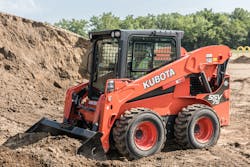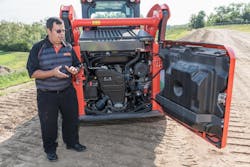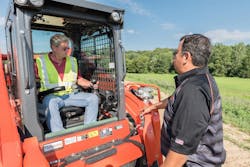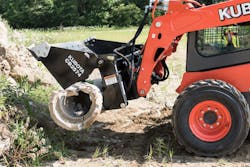Although Kubota has taken its share of the compact track loader (CTL) market since introducing two CTL models in 2010 (and a more-powerful replacement model last year), the company is a relative newcomer to the skid-steer loader (SSL) market, having officially introduced its SSV65 and SSV75 models only two years ago. Jorge De Hoyos, Kubota’s senior product manager, SSL/CTL, makes no excuse for Kubota’s late entry into the SSL market, saying that the company simply needed time to develop the Kubota skid steer models—with rated operating capacities of 1,950 and 2,690 pounds, respectively—around an SSL-specific platform, not a modification of the CTL design.
Wheelbase, for instance. “Opinions differ about wheelbase length for skid steers,” De Hoyos told us, “with some saying that longer is better for increased stability. That might be true if the machine were always operated in a straight line, but stability has to be balanced with the machine’s maneuverability, operating smoothness, tire wear, and its ability to hold a grade. We think our wheelbase lengths [44.3 and 47.2 inches, respectively] are the optimum dimensions for overall balance and performance based on machine size.”
Bill Cinnamon, our operator for the in-field evaluation of the Kubota skid steer and an instructor for IUOE Local 649’s (Bartonville, Ill.) apprentice training program, agreed with De Hoyos’ assessment. “Overall, the Kubota is a very stable, well-balanced machine.”
Kubota responded to Construction Equipment’s request for a test machine by delivering to Local 649 a factory-fresh, cab-equipped (with standard air conditioning) Kubota SSV75 with all available options: ride control (Kubota Shockless Ride); high-flow auxiliary hydraulics (increases flow from 20.9 to 30.4 gpm); ISO pilot controls (versus mechanical hand/foot controls); hydraulic coupler; and self-leveling loader linkage.
Kubota skid steer features
Standard features include two-speed drive, sliding front glass (stores in the roof of cab models), suspension seat (air-ride is a dealer option), and radio-ready. Tires on this machine were Titan HD 2000 II (12-16.5 NHS). The Kubota SSV75 arrived with its standard bucket, a power rake attachment, and a 4-in-1 multipurpose bucket.
As equipped, the Kubota SSV75 has an operating weight of 8,400 pounds. Engine is a 74.3-horsepower (gross) Kubota V3307-CR-TE4, which uses a diesel particulate filter, is mounted longitudinally (facilitates routine service, says Kubota), and directly drives the pumps (variable-displacement for propel, gear for implements, and gear for high-flow). Loader relief is set at 3,271 psi.
The machine has a vertical-lift loader arrangement, and the optional self-leveling feature can be switched on or off. Self-leveling is hydraulically actuated and works only when the lift arms are being raised. The linkage also has float capability.
Among the machine’s distinctive features—and one that usually raises the eyebrows of perspective buyers, said De Hoyos—is a fuel tank mounted inside the engine-compartment door (left). De Hoyos explained, however, that the tank is well-protected behind the heavy-duty (3/16-inch steel) door, is separated from the door with a 1-inch air gap, and provides the benefit of freeing engine-compartment volume, making service points more accessible. The machine is rated with an empty tank, said De Hoyos, but a full tank adds about 175 pounds of extra counterweight.
“There’s an initial resistance to the tank’s location,” said Cinnamon. “But when you think about Kubota’s overall design and placement of the tank, there’s really no problem with it. And I do agree that the tank’s placement cleans up the engine compartment and gives more room for servicing the machine.”
How does the Kubota SSV75 perform?
Construction Equipment asked Cinnamon to work the Kubota SSV75 as he would on a typical job site, including moderate digging, loading trucks, short-cycle load-and-carry, trimming next to a curb with the rake, and using the 4-in-1 bucket in all four of its configurations—clam, scraper, dozer, and general-purpose bucket. We also asked that he run the machine with the self-leveling feature off, then on, to assess its effectiveness; same with ride control. We pass along his thoughts from an operator’s perspective.
Pilot controls and hydraulics
“Actually, I prefer pilot controls over electro-hydraulic controls, because in my opinion, pilot controls provide more feedback and generally are more responsive and intuitive than EH controls,” said Cinnamon. “From the perspective of a trainer working with novice operators, I’d like having the option of switching control patterns—but that said, overall, this machine has very quick, responsive hydraulics, compared with similar machines we have on site. Actually, I was initially a bit surprised by the speed of the hydraulics. The machine fills the bucket aggressively, and it has good grading control.”
Ride control and self leveling
“Ride control on a skid steer is obviously a good idea,” said Cinnamon. “This system is impressive, both for material retention in rough going and the quality of the ride. The self-leveling feature is also a plus—especially for inexperienced operators. But I think the system is of advantage to operators of all skill levels. Some operators might say that self-level slows down the cycle a bit, but overall, it’s a worthwhile feature to have.”
De Hoyos told us that the options of ride control and self-leveling are paired from the factory.
Coupler
In similar fashion, said De Hoyos, closed-cab models are factory-equipped with the hydraulic coupler. The coupler, however, can be installed on open-cab models.
“I like the design of this coupler for two reasons,” said Cinnamon. “First, it has hydraulic actuation—not electric—and second, it uses a very stout cylinder that seems to have the power to function even when mud and debris might collect in the coupler area.
“Some couplers today are electrically actuated, and when that type of mechanism is restricted by debris, it might not have the power to function, and the gearing involved in moving the pins could be easily stripped.
“I also like that the indicator arms give you visual confirmation that the attachment is fully engaged—but you always do a positive-function test to make sure
it’s locked.”
Operator’s environment
Kubota equips its closed-cab models with a front glass door that slides upward, stores in the roof of the cabin, and is secured with two locking pins. Cinnamon sees advantages and possible disadvantages to the design, compared with a conventional swing-out door.
“Every operator has probably been in a situation where the position of the machine or attachment has restricted the movement of a swing-out door,” he said. “An overhead door eliminates that problem—and that’s a valuable feature.
“If there’s a downside to the overhead door, it might be that it’s somewhat of a barrier to communicating with people on the job site—always having them come to the side of the machine and sliding open the side window—versus just popping open the swing-out door to talk to a laborer.
“I always look, too, at how well a design will age. Will the more complicated design of the overhead cause problems down the road? But that said, I think the overhead door makes for a cleaner front end. Also, the forward visibility on this machine is very good, but I don’t know if that’s directly related to the door’s design—could be.
“The cab, overall, is quite roomy, plenty of leg room for taller operators—some skid steers are lacking in that regard. Visibility is good, and the cab is very quiet. Also like the control layout—auxiliary [hydraulic] controls are handy, and frequently used controls are visible and within fingertip reach—you don’t have to divert your attention from the work.
“I think Kubota has done a good job with the lighting package. You have both front and side lights, which I think would be quite valuable—snow removal comes to mind.
Kubota SSV75 Attachments
“The rake that Kubota sent with the machine worked well. Manufacturers have improved the design of rakes over the years, and they can save a lot of handwork. On this one, the ability to change the angle and the direction of rotation are plus features.
“This is the first Kubota machine of any type I’ve experienced; I’d give it a thumbs up all around.”
Kubota SSV75 Skid Steer Specifications
- Operating weight: 8,400 pounds
- Engine: Kubota V3307-CR-TE4
- Power: 74.3 horsepower








